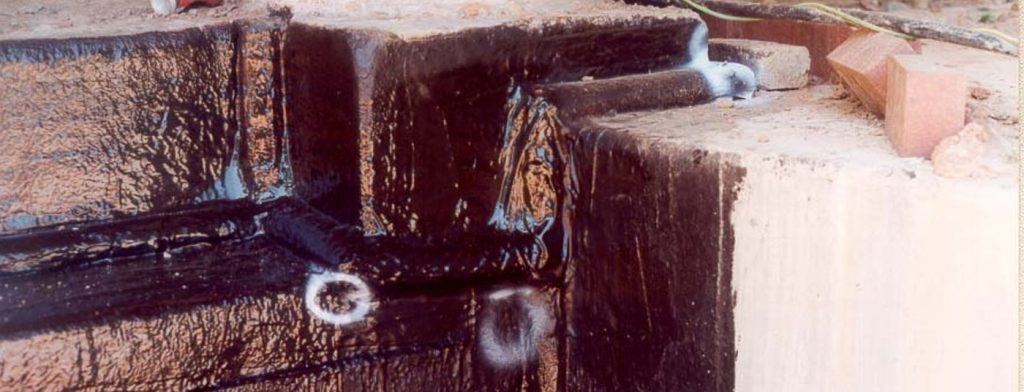01732 360 095
Note: This article was written by Bob Cather (BSc, CEng, FIMMM) when the British Standard 8102:2009 version was the prevalent code of practice for the protection of below-ground structures against water from the ground.
The question of whether to use a ‘tanking’ membrane or a specialist waterproofing admixture to create a waterproof concrete waterproofing structure is a regular feature in the overall design of concrete structures, be it basements, tunnels, water tanks, swimming pools etc.
Waterproofing of Concrete Admixtures – How do Concrete Admixtures Work?
There are very many ‘waterproofing’ admixtures on the market worldwide that can be added to the concrete at mixing intended to achieve enhanced resistance to water migration. Across the range of products, there are many common features and differences. The promotion of these systems through the pages of this journal and elsewhere, often comes with attractive claims for performance, ease of use and backup ‘warranties’.
Although the different products may claim different composition and or mode of action – pore-lining repellency, crystal forming pore blocking, organic pore plugging under pressure – the presentation of claims, technical back-up, warranties have much in common across the majority of the products offered.
This discussion paper seeks to bring together the key issues and claims and presents some evaluation of the materials and invites a rigorous debate of benefits and expectations.
This is not intended to be a specific approval or rebuttal of individual claims on specific individual products. Although there is reference made to some UK technical documents, the materials, the claims and the issues are relevant worldwide.
Two headline views, derived below, is that the use of such admixtures alone is very unlikely to substantially improve the structural concrete’s ability to resist the passage of liquid water and any claimed improvement to the resistance to water vapour, is more uncertain. An important distinction is made, here and later in this paper, between water penetration through ‘structural concrete and that through a structure constructed in concrete.

BS 8102:2009 Section 9 – Achieving ‘Structurally Integral Protection’
This discussion paper is relevant now for the UK and other countries using British Standards for waterproofing underground structures. British Standard BS 8102 (1) has been revised and republished. Section 9 of the Standard relates to the selection of materials to achieve ‘structurally integral protection’ – that is where the concrete itself is required to give the required degree of resistance to minimise the ingress of water.
Clause 9.2.1.3 Concrete containing waterproofing admixtures, states in a commentary:
“There is a range of products, generally recognised as waterproofing admixtures, which seeks different ways to increase the inherent resistance of concrete to water and water vapour. As the mechanism used by each product to achieve these aims are quite diverse, it is not possible in this British Standard to give specific guidance on their use”
So it is up to the individual to judge.
It also advises that waterproofing admixtures are specified in BS EN 934 (2). That standard specifies testing to EN 480-1 and EN 480-5. However the requirement for ‘capillary absorption’ – the relevant property of those required in the standard in regard to waterproofing – is of the reduction in water absorption by a reference mortar. This is not very useful in assessing the likely water penetration performance of concrete.
BBA Certification For Admixtures
A source of independent assessment of products outside the national standards is certification by Agrément or other technical approval bodies. The British Board of Agrément has examined some of these waterproofing admixtures and has issued certificates of performance.
These certificates generally record that concretes containing the special admixture produce concrete with lower water permeability compared to a reference concrete. The certificates are more ambivalent about effects of adopting these modified concretes on the overall water exclusion of a below ground structure.

Water Leakage Through Cracks and Service Penetrations
It is common experience, drawn from real projects that water leakage through a concrete structure is predominantly not through the body of well compacted concrete, but rather where the concrete isn’t – at cracks, at joints at service penetrations, etc. Where the concrete itself is of poor quality – exhibiting poor compaction or having inclusions – there may be water leakage but the admixtures seeking to ‘improve’ the concrete matrix cannot be expected to provide benefit in such circumstances.
Thus although the concrete containing the admixture may be shown to have higher resistance to water ingress, this does not mean the structure itself will be more resistant. The argument that structural quality concrete has a very high degree of inherent ‘waterproofness’ is supported by many so-called ‘permeability’ tests that have been carried out (3). Establishing a true ‘flow’ condition in a laboratory test is extremely difficult for concrete representing the low permeability mass typical of structural concrete.
More success in demonstrating resistance to water passage has been achieved using pressure penetration methods. One such test method is set out in BS EN 12390-8:2000. In that test, concrete samples are subject to an applied pressure of 500kPa (approx 50m water head) for a period of 72hrs. The results obtained for structural concretes range from 10 – 40mm penetration.
Water Permeability
There is also some doubt as to whether the apparent improvement in water permeability property of the concretes tested by the certification bodies, is actually from the ‘active’ ingredient and not due to other changes between the control concrete and the test concrete. The table below summarises the data from some issued assessment certificates. It shows and contrasts the composition and performance detail declared.

A first comment to make is that, according to guidance on permeability (3), all of the permeability results above – test and control – would be classified of concrete of low permeability (concrete permeability < 10 -12) . There is a further degree of uncertainty about the conclusiveness of these tests, if the permeability results shown in the table for the notionally similar control specimens.
If we have good quality concrete, that is good enough in terms of permeability is there really benefit in making a concrete that is say, five times better?
For some of the products above e.g. ‘δ’ or ‘ε’ the differences in permeability could plausibly derive from the substantial reduction in w/c ratio between control and test. The link between w/c ratio and permeability is well established.
From the above arguments, there seems little benefit in adopting a special formulation waterproofing admixture to achieve better resistance against liquid water ingress.
These arguments typically come up in a contractor suggested alternative to a membrane-based waterproofing design. But, if the concrete itself can be waterproof enough – with judicious attention to joints and penetrations – why opt for a membrane at all? Confidence, habit, vapour control, durability? The factors and guidance involved with these wider issues are, at present rather less well defined and conclusions rather more difficult to draw.
Water Vapour Permeability Considerations
We would instinctively conclude perhaps, that whilst concrete can exclude liquid water it may permit passage of water vapour. It is true that making measurements of water vapour permeability is easier to achieve than with liquid water. The major uncertainty with consideration of water vapour is to decide what level of vapour ingress can be permitted. The terminology used in some design guides do not help – ‘dry’ or ‘totally dry’ – define the required transmission performance of the concrete. Additionally, the design for control of water vapour ingress is to a greater extent influenced by the nature of the use of the internal space and the mechanical services – dehumidification, ventilation etc. This has been recognised by the revision to BS 8102 has removed the previous Grade 4 environment.
The Agrément certificates for some of the waterproofing admixtures have attempted to put a performance requirement on the concrete that would meet vapour resistance needs of the superseded BS 8102. However, on the values stated and allowing for typical concrete construction sections, it can be shown that the control concrete without the admixture can meet the vapour transmission requirements.
Hence the conclusion at present is that individual project needs and perceived risks will need to be considered in deciding whether there is benefit in adopting one of these admixtures in a concrete-alone solution or to design on the basis of a tanking membrane system.
The Use of External Tanking Membranes for Below Ground Concrete Structures
A significant use of external tanking membranes for below ground concrete structures world-wide is to provide protection against deterioration in aggressive ground or groundwater conditions. As with resistance against water ingress, the promoters of these admixtures make considerable claims about enhanced durability performance.

Unfortunately most projects have their durability design based not on performance, but on prescriptive rules for various exposure conditions. The application of a robust tanking membrane can make very positive statements about changing the exposure conditions the concrete will experience.
The adoption of a water permeability reducing admixture, will change, usually improving, the resistance to deterioration, but to an extent that cannot be readily defined against code or other references used for design. If we use admixture X by how much could we reduce minimum cement content or by how much increase the maximum w/c ratio on any given site. At present there is very limited guidance. This should not be taken to mean there are no situations in which any durability benefits are useful. There will be such situations, where for example applying a tanking membrane to a structure is not feasible.
Warranties For Concrete Admixtures
The admixture manufacturer offer of warranties was mentioned earlier in this note. These can outwardly be attractive in establishing confidence in the waterproofing option. In précis terms the warranty will offer to oversee the detail of waterproofing design, have some contribution to site practice and significantly, warrant that if there is a leak they’ll come back and ‘fix’ it.
On those projects that we’ve encountered a warranty in place, the arrangement appears to work to a large degree. However typical warranty documents have potentially significant issues. Returning to ‘fix’ the leaks only covers the act of grouting or patching or whatever is required. The supplier will normally be expected to be provided free (in both senses) access to the defect. This may be difficult and have significant on-cost if the leak becomes apparent only after the space has been fitted out with plant and other equipment. Leaks may not become apparent until sometime after the construction has been completed. A further common limitation is that the cost of the ‘fix’ will only be covered up to the cost of the admixture originally supplied.
These warranties may well be a positive contribution for particular projects but it is recommended that the warranty terms are vigorously reviewed.
There is hopefully a wider and more detailed debate to be had on the issues raised in this paper. There is certain to be a spread of views, experiences and expectations across the UK construction industry.
Discuss!
Newton Waterproofing Systems thank Bob Cather for his submission of this article.
For more information, read our page on Waterproofing Concrete Structures, and learn about our concrete joint and leak sealing products and our reinforced concrete structures.
Speak to our friendly, expert team
Our staff are able to provide guidance for projects of all sizes, whether you require some general advice about damp or waterproofing, or support with technical drawings and specifications.













